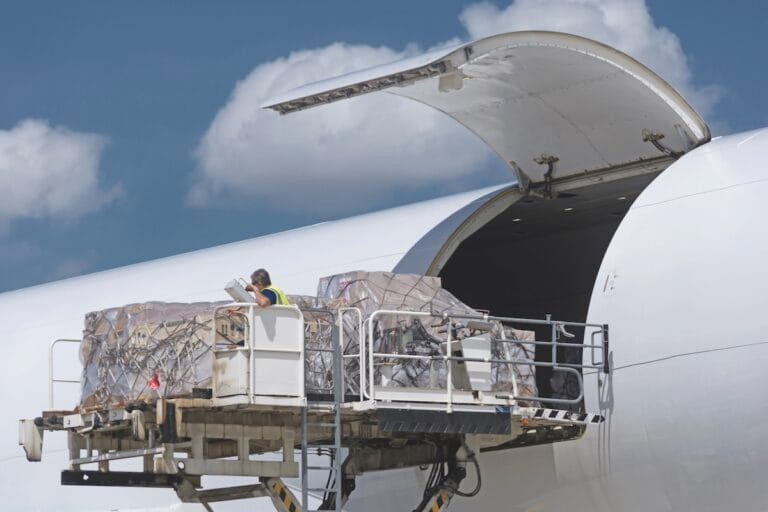- Global air cargo, driven by e-commerce, faces volatility from US-China trade tariffs, geopolitical conflicts, and regulatory changes, with China-US volumes dropping up to 60 percent in 2025.
- Airlines are adjusting networks and capacity to shifting demand, while stricter customs and FDA requirements slow deliveries and increase costs.
- AI and predictive analytics optimise pricing, flight planning, and disruption management, reducing planning errors by 30–50 percent and boosting efficiency.
- Automation and autonomous ground handling systems (AGVs) improve cargo throughput, lower labor costs, and enhance safety, increasing handling efficiency up to 30 percent.
Across the world, logistics operations have been subject to unprecedented challenges, spurring innovation to meet emerging demands. This is particularly obvious in the air cargo sector – once seen as a relatively traditional branch of global logistics – which has undergone a profound transformation that has seen it evolve into a highly dynamic and technologically advanced sector. While the global airfreight market had been recovering well post-Covid-19, the current outlook remains mixed. In January 2025, the International Air Transport Association (IATA) forecasted the air cargo sector to grow by 3.2 percent, led by growth in e-commerce. Approximately one-half of air cargo shipments out of Asia this year is expected to be related to e-commerce. The influx of large online marketplaces, executing direct-to-consumer fulfillment strategies from China, is replacing traditional freight like apparel, electronics and automotive parts, and influenced the upward move in yields.
But due primarily to the sudden and unexpected adjustments in US trade tariffs, the growth outlook has changed. In June, just six-months after its bullish forecast, IATA stated that it now expects a 1.0 percent contraction due to trade disputes and tariffs. In Mexico, for example, international air cargo surged 7 percent in 2024. However, in the first four months of 2025, international volumes dropped 6.8 percent.
Within weeks of the May 2nd elimination of the de minimis exemption for China and Hong Kong, trans-Pacific e-commerce bookings from China to the U.S. fell 50 percent, and China-US and overall cargo volumes have dropped up to 60 percent since reciprocal tariffs were announced in April.
Air cargo carriers are reassessing and reconfiguring their route networks in response to falling demand on China-U.S. routes. Airlines are adjusting their networks to this new reality, which may lead to more capacity becoming available on other trade lanes globally.
New requirements include full customs documentation, stricter compliance checks, and slower last-mile delivery for goods that previously benefited from de minimis exemptions. All de minimis-eligible imports regulated by the FDA now require agency review prior to entry, adding processing time and compliance costs, signaling broader regulatory scrutiny.
Furthermore, geopolitical instability such as the ongoing conflicts in Ukraine and the Middle East continue to create volatility, forcing carriers to re-evaluate capacity allocation and reshaping global cargo flows.
For example, the Israel-Iran conflict made oil price volatility front-page news again. Fuel represents one of the largest operating costs for carriers, and these expenses are tied to crude oil prices so can fluctuate from year to year. For example, in late August, jet fuel prices averaged US$3.07 per gallon, a 50 percent increase from a low of US$2.05 in early May.
Digital transformation through AI
In response to these challenges, air cargo carriers are focusing on several strategic priorities to maintain competitiveness and profitability. One such methos is the adoption of Artificial Intelligence (AI), automation, and predictive analytics to enable dynamic pricing, increase capacity efficiency and boost optimisation through optimised forecasting.
AI has become a valuable tool as it powers dynamic pricing engines help carriers maximise yield while minimising empty space. In addition, AI assists in intelligent flight planning, leading to significant fuel savings with Alaska Airlines’ Flyways system saving 480,000 gallons annually. AI is also critical to Optical Character Recognition (OCR) technologies which digitise paper Air Waybills (AWBs), reducing human error rates and accelerating conversion times to digital formats by 80 percent.
Furthermore, operational planning using predictive analytics allows airlines to anticipate disruptions due to weather events, labor shortages, or port congestion, allowing carriers to reroute flights or adjust loading schedules in advance. Logistics companies implementing AI forecasting have seen a 30-50 percent reduction in planning errors and inventory mismatches.
Autonomous ground handling systems and AI-driven scheduling tools are already streamlining airport operations. Autonomous Guided Vehicles (AGVs) transport freight, which reduces labor costs, improves safety, and decreasing turnaround times. This type of automation can increase cargo handling efficiency by up to 30 percent.
These developments are encouraging, and are helping the air cargo market experience growth and stability at a time of unprecedented uncertainty and disruption. By embracing innovative approaches, the industry is presenting a roadmap for other logistics practitioners and helping to make global supply chains safer, more efficient, and environmentally friendly.





